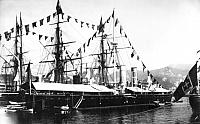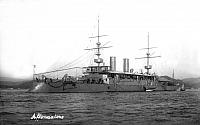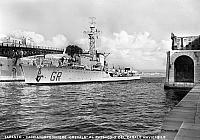AFFONDATORE
Unità della Regia Marina, coevo della USS Miantonomoh, è il primo esempio di unità navale al mondo, completamente corazzata con le artiglierie poste in torretta sul ponte di coperta e non lungo il ponte di batteria: risultato di una logica evoluzione dei precedenti progetti navali che avevano portato alla realizzazione, nel 1860, delle fregate corazzate La Gloire e HMS Warrior.
Costruito interamente in ferro, dotato di uno sperone di 2,5 mt., aveva un dislocamento di oltre 4.500 ton. a p.c., una lunghezza f.t. di oltre 93 mt. Aggiungeva alla propulsione principale ad elica anche quella ausiliaria a vela con armatura a goletta.
La corazzatura in ferro battuto ricopriva completamente oltre il ponte di coperta con uno spessore di 50 mm., anche le altre parti della nave con uno spessore di 127mm:
• le fiancate al di sopra della linea di galleggiamento per 2,20 mt. e al di sotto per 1,2 mt;
• le torrette, una a prora e una a poppa, poste sul ponte di coperta, in ciascuna delle quali era alloggiato un cannone Armstrong Mark IV ad avancarica da 254/30mm.
• la torre di comando cilindrica con otto feritoie per la visibilità esterna.
Pur essendo stato ordinato nel 1862 per varie vicissitudini, riuscì ad essere varato nei cantieri navali Harrison di Millwall di Londra solamente nel 1865.
Fu ritirato dalla Regia Marina con urgenza dal cantiere, il 20 giugno 1866, allo scoppio della Terza guerra di Indipendenza, con le prove in mare non ancora completate, per essere integrato nell’Armata navale schierata in Adriatico.
Divenne la corazzata ammiraglia sulla quale Carlo Pellion di Persano imbarcò nell’imminenza dello scontro navale con la flotta austrica nelle acque dell’isola di Lissa.
In questa battaglia l’Affondatore mostrò tutti i suoi difetti e limiti:
• l'apparato motore sottodimensionato, non in grado di imprimere la velocità massima di progetto di 12 nodi;
• poco stabile e poco manovriero;
• limitata visibilità del campo di battaglia dovuta alle feritoie della torretta di comando.
Ne uscì alquanto malconcio per i numerosi proiettili incassati, non speronò alcuna nave e mise a segno solo un colpo di cannone, non determinante, sull’SMS Kaiser.
Il 6 agosto del 1866, ancora gravemente danneggiato, affondò per un fortunale abbattutosi su Ancona. Recuperato, fu sottoposto a grandi lavori nell’Arsenale della Spezia, ultimati nel 1870.
In seguito fu riammodernato radicalmente nel 1883 con l’installazione di:
• un nuovo ponte comando al posto della torretta;
• un apparato motore più potente;
• altri n.6 cannoni Armstrong da 120/40 mm;
• n.2 nuovi alberi con coffe da combattimento;
• n.4 tubi lanciasiluri da 450 mm.
Nel 1891, divenne sede per nave scuola per siluristi e radiato nel 1907.
Unit of the Regia Marina, contemporary with the USS Miantonomoh, it is the first example of a naval unit in the world, fully armored with the artillery placed in the turret on the deck and not along the battery deck: the result of a logical evolution of the previous naval projects that had led to the construction, in 1860, of the armored frigates La Gloire and HMS Warrior.
Built entirely of iron, equipped with a spur of 2.5 meters, it had a displacement of over 4,500 tons. at f.l., an overall length of over 93 meters. It added to the main propeller propulsion also the auxiliary sailing propulsion with schooner armor.
The wrought iron armour completely covered the other parts of the ship with a thickness of 127 mm. in addition to the main deck with a thickness of 50 mm.:
• the sides above the waterline for 2.20 m. and below for 1.2 meters;
• the turrets, one fore and one aft, located on the main deck, in each of which was housed an Armstrong Mark IV 254/30mm muzzle-loading gun.
• the cylindrical control tower with eight slits for external visibility.
Although it was ordered in 1862 due to various vicissitudes, it was only launched at the Harrison Shipyard in Millwall, London, in 1865.
It was urgently withdrawn from the shipyard by the Regia Marina on 20 June 1866, at the outbreak of the Third War of Independence, with sea trials not yet completed, to be integrated into the Naval Army deployed in the Adriatic sea.
It became the flagship battleship on which Carlo Pellion di Persano embarked in the imminence of the naval clash with the Austrian fleet in the waters of the island of Vis.
In this battle, the AFFONDATORE showed all his flaws and limitations:
• the undersized engine apparatus, not able to give the maximum design speed of 12 knots;
• not very stable and not very maneuverable;
• limited visibility of the battlefield due to the embrasures of the command turret.
He came out rather battered by the numerous shells he had received, did not ram any ships and scored only one cannon shot, not decisive, on the SMS Kaiser.
On 6 August 1866, still badly damaged, it sank due to a storm that hit Ancona. Recovered, it underwent major works in the Arsenal of La Spezia, completed in 1870.
It was later radically modernized in 1883 with the installation of:
• a new command tower in place of the cylindrical turret;
• a more powerful engine;
• 6 x 120/40 mm Armstrong guns;
• n.2 new masts with fighting crow's nests;
• n.4 x 450 mm torpedo tubes.
In 1891, it became the training ship for torpedo pilots and was decommissioned in 1907.
Costruito interamente in ferro, dotato di uno sperone di 2,5 mt., aveva un dislocamento di oltre 4.500 ton. a p.c., una lunghezza f.t. di oltre 93 mt. Aggiungeva alla propulsione principale ad elica anche quella ausiliaria a vela con armatura a goletta.
La corazzatura in ferro battuto ricopriva completamente oltre il ponte di coperta con uno spessore di 50 mm., anche le altre parti della nave con uno spessore di 127mm:
• le fiancate al di sopra della linea di galleggiamento per 2,20 mt. e al di sotto per 1,2 mt;
• le torrette, una a prora e una a poppa, poste sul ponte di coperta, in ciascuna delle quali era alloggiato un cannone Armstrong Mark IV ad avancarica da 254/30mm.
• la torre di comando cilindrica con otto feritoie per la visibilità esterna.
Pur essendo stato ordinato nel 1862 per varie vicissitudini, riuscì ad essere varato nei cantieri navali Harrison di Millwall di Londra solamente nel 1865.
Fu ritirato dalla Regia Marina con urgenza dal cantiere, il 20 giugno 1866, allo scoppio della Terza guerra di Indipendenza, con le prove in mare non ancora completate, per essere integrato nell’Armata navale schierata in Adriatico.
Divenne la corazzata ammiraglia sulla quale Carlo Pellion di Persano imbarcò nell’imminenza dello scontro navale con la flotta austrica nelle acque dell’isola di Lissa.
In questa battaglia l’Affondatore mostrò tutti i suoi difetti e limiti:
• l'apparato motore sottodimensionato, non in grado di imprimere la velocità massima di progetto di 12 nodi;
• poco stabile e poco manovriero;
• limitata visibilità del campo di battaglia dovuta alle feritoie della torretta di comando.
Ne uscì alquanto malconcio per i numerosi proiettili incassati, non speronò alcuna nave e mise a segno solo un colpo di cannone, non determinante, sull’SMS Kaiser.
Il 6 agosto del 1866, ancora gravemente danneggiato, affondò per un fortunale abbattutosi su Ancona. Recuperato, fu sottoposto a grandi lavori nell’Arsenale della Spezia, ultimati nel 1870.
In seguito fu riammodernato radicalmente nel 1883 con l’installazione di:
• un nuovo ponte comando al posto della torretta;
• un apparato motore più potente;
• altri n.6 cannoni Armstrong da 120/40 mm;
• n.2 nuovi alberi con coffe da combattimento;
• n.4 tubi lanciasiluri da 450 mm.
Nel 1891, divenne sede per nave scuola per siluristi e radiato nel 1907.
Unit of the Regia Marina, contemporary with the USS Miantonomoh, it is the first example of a naval unit in the world, fully armored with the artillery placed in the turret on the deck and not along the battery deck: the result of a logical evolution of the previous naval projects that had led to the construction, in 1860, of the armored frigates La Gloire and HMS Warrior.
Built entirely of iron, equipped with a spur of 2.5 meters, it had a displacement of over 4,500 tons. at f.l., an overall length of over 93 meters. It added to the main propeller propulsion also the auxiliary sailing propulsion with schooner armor.
The wrought iron armour completely covered the other parts of the ship with a thickness of 127 mm. in addition to the main deck with a thickness of 50 mm.:
• the sides above the waterline for 2.20 m. and below for 1.2 meters;
• the turrets, one fore and one aft, located on the main deck, in each of which was housed an Armstrong Mark IV 254/30mm muzzle-loading gun.
• the cylindrical control tower with eight slits for external visibility.
Although it was ordered in 1862 due to various vicissitudes, it was only launched at the Harrison Shipyard in Millwall, London, in 1865.
It was urgently withdrawn from the shipyard by the Regia Marina on 20 June 1866, at the outbreak of the Third War of Independence, with sea trials not yet completed, to be integrated into the Naval Army deployed in the Adriatic sea.
It became the flagship battleship on which Carlo Pellion di Persano embarked in the imminence of the naval clash with the Austrian fleet in the waters of the island of Vis.
In this battle, the AFFONDATORE showed all his flaws and limitations:
• the undersized engine apparatus, not able to give the maximum design speed of 12 knots;
• not very stable and not very maneuverable;
• limited visibility of the battlefield due to the embrasures of the command turret.
He came out rather battered by the numerous shells he had received, did not ram any ships and scored only one cannon shot, not decisive, on the SMS Kaiser.
On 6 August 1866, still badly damaged, it sank due to a storm that hit Ancona. Recovered, it underwent major works in the Arsenal of La Spezia, completed in 1870.
It was later radically modernized in 1883 with the installation of:
• a new command tower in place of the cylindrical turret;
• a more powerful engine;
• 6 x 120/40 mm Armstrong guns;
• n.2 new masts with fighting crow's nests;
• n.4 x 450 mm torpedo tubes.
In 1891, it became the training ship for torpedo pilots and was decommissioned in 1907.
-

AFFONDATORE
-

AFFONDATORE
-

AFFONDATORE
-

AFFONDATORE
-

AFFONDATORE
-

AFFONDATORE
-

AFFONDATORE
-

AFFONDATORE
-

AFFONDATORE
- Primo Precedente
- Foto 1 - 9 di 10
- Prossimo Ultimo
